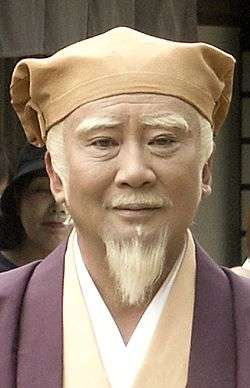Mito Kōmon
| Mito Kōmon | |
|---|---|
 Satomi Kōtarō on set in the role of Mitsuemon | |
| Country of origin | Japan |
| No. of episodes | 1,227 |
| Production | |
| Producer(s) | C.A.L. |
| Running time | 54 min. |
| Release | |
| Original network |
TBS ABC (1969 - 1975) MBS (1975 - 2011) |
| Picture format |
NTSC 625-line colour (1969–2003) 720x576 16:9 (2003 1000th special–) |
| Original release | 4 August 1969 – 19 December 2011 |
| External links | |
| Website | |
Mito Kōmon (水戸黄門) is a Japanese jidaigeki or period drama that was on prime-time television from 1969 to 2011 making it the longest-running jidaigeki in Japanese television history. The title character is the historic Tokugawa Mitsukuni, former vice-shōgun and retired second daimyō of the Mito Domain. In the guise of Mitsuemon, a retired crêpe merchant from Echigo, he roams the realm with two samurai retainers, fun-loving Sasaki Sukesaburō (Suke-san) and studious Atsumi Kakunoshin (Kaku-san). An episode typically starts with some injustice perpetrated by a corrupt official, wealthy merchant or gangster; the travelers arrive incognito, discover the injustice and quietly investigate it; and the episode concludes with a brawl in which the unarmed, disguised protagonists defeat a crowd of samurai and gangsters, culminating with the presentation of the inrō that reveals the hero's identity. Afterwards, the hero passes judgement upon the villains, and sets things straight with fair comments and encouragements, and then continues with his journey.
History and characters
Five actors have portrayed the lead character in the series. Eijirō Tōno created the part and appeared in 13 seasons. His successor was Kō Nishimura. Asao Sano followed, and Kōji Ishizaka took the role in two seasons, quitting for cancer treatments. Kōtarō Satomi, played Mitsuemon from 2002 until the end of the series in 2011.
The character normally sports a pointed white beard. He wears the lavish garb of a wealthy retiree, and carries a walking stick (a staff), which also serves as his defensive weapon in combat.
Singer-actor Ryōtarō Sugi was the series' first Suke-san, followed by Kōtarō Satomi (who many years later took over the lead role). Teruhiko Aoi was next, then Yūji Kishimoto, and Ryūji Harada. Opposite them, Tadashi Yokouchi, Shin'ya Ōwada, Goro Ibuki, Jundai Yamada, and Masashi Gōda have played Kaku-san. Ichiro Nakatani played Kazaguruma no Yashichi, a ninja who helped Mitsuemon. Evil characters who tried to kill Mitsuemon were played by such actors as Shigeru Tsuyuguchi (1st season) and Mikio Narita (3rd season).
In each of the show's 42 seasons, various other regular characters have joined the retinue. For many years, it was the food-loving commoner Hachibei; the reformed thieves Kazaguruma no Yashichi (a former ninja whose main weapon is a shuriken with pinwheel, with a dagger as his sidearm) and his wife Kasumi no Oshin; the ninja Tsuge no Tobizaru; and kunoichi Kagerō Ogin. Portrayed by Kaoru Yumi, Ogin was the lead character in a light-hearted spinoff, Mito Kōmon Gaiden Kagerō Ninpō-chō. The same actress took on a new role, Hayate no Oen, in which she continues as of 2007.
Many former regular actors appeared in the show's gala 1000th special episode, which aired on December 15, 2003. A 1978 film distributed by Toei Company shared the cast, production crew, and title.
Since its inception, the program has been a mainstay of the Panasonic Drama Theater (formerly known as the National Theater), sponsored by Panasonic. The TBS network airs the show throughout Japan, and shows reruns on both its analogue stations and its CS satellite channel. For nearly three decades, Mito Kōmon shared the time slot with Ōoka Echizen, and various actors and actresses appeared in both series.
An unusual feature of the series is that the credits list the maker of the inrō. The last episode aired on December 19, 2011.
There was also an animated adaptation called Manga Mito Kōmon (まんが水戸黄門) that aired during 1981-1982, animated by Knack Productions.
In the light novel "Death March kara hajimaru isekai", the main protagonist quotes Mito Komon somewhat frequently. He also made a firm by the name Echigoya.
References
This article is based in part on the article 水戸黄門 (テレビドラマ) in the Japanese Wikipedia, retrieved April 12, 2007. That article is now 水戸黄門 (パナソニック ドラマシアター).
Bibliography
- Schilling, Mark (1997). "Mito Komon". The Encyclopedia of Japanese Pop Culture. New York: Weatherhill. pp. 135–138. ISBN 0-8348-0380-1.
External links
- Mito Kōmon at TBS (in Japanese)
- Mito Kōmon at C.A.L (in Japanese)
- http://us.imdb.com/title/tt1172114/